Today, I am reviewing a new NY Meyer 100th Anniversary Model Alto Saxophone Mouthpiece by JJ Babbitt. The vintage NY Meyer alto sax mouthpieces from the 1960’s are some of the most sought after vintage alto sax mouthpieces on the market today. When I heard the news that JJ Babbitt was coming out with a new NY Meyer alto saxophone mouthpiece for their 100th anniversary, I had to try one of these NY Meyer mouthpieces out. It turns out that I was lucky enough to try out five in the process!
NY Meyer 100th Anniversary Model Alto Saxophone Mouthpiece-on left normal beak-on right duckbill beak
I reached out to JJ Babbitt a couple times to see if I could get a NY Meyer saxophone mouthpiece to review but both times they didn’t have any available to send me as they seem to have their hands full just filling existing mouthpiece orders. Luckily, Dave Kessler at Kessler & Sons Music and Simon Harding at Tenor Madness both volunteered to let me borrow some of the new NY Meyer sax mouthpieces for this review. In total I received three 6’s and two 7’s to review.
Normally, I do not need this many mouthpieces for one review but there was some confusion over the beaks of these new NY Meyer mouthpieces. Right around the time I started asking for mouthpieces to review, I also started hearing from players that the new NY Meyer mouthpieces had a unique (some described it as strange….) duckbill shape to the beak(a duckbill beak has a very low profile which looks a bit like a duck’s bill). Vintage NY Meyer alto mouthpieces do not have duckbill beaks. Some people were reporting NY Meyer mouthpieces with this new duckbill beak but others were reporting normal height Meyer type beaks on their NY Meyer mouthpieces. People were posting pictures on SOTW (Sax on the Web) of the different beaks. Many of us were quite confused.
By this point, I already had a 6 and 7 tip NY Meyer alto mouthpiece on their way to me and I found out that these also had the duckbill beaks. I also heard that Tenor Madness had the regular beaked NY Meyers in stock and Simon agreed to send me three of the regular beaked NY Meyer mouthpieces to review as well.
I figured that if there were two versions of these new NY Meyer alto sax mouthpieces out there, that I might as well review both of them so my readers will have an idea of what is going on. Here are some photos so you can see the differences in the beaks:
NY Meyer 100th Anniversary Model Alto Saxophone Mouthpiece-on left normal beak-on right duckbill beak
NY Meyer 100th Anniversary Model Regular Beak Alto Saxophone Mouthpiece
NY Meyer 100th Anniversary Model Duckbill Beak Alto Saxophone Mouthpiece
As you can see in the picture above, the duckbill beak Meyer mouthpiece is much thinner than the regular beak mouthpiece.
Why or how two different versions of a newly released mouthpiece exist is something you will have to ask JJ Babbitt. I figure that someone either screwed up at the factory or JJ Babbitt had for whatever reason decided that the duckbill beak was a good choice. I also was wondering if maybe they had two models of the newly released NY Meyer for those who would prefer a different beak angle.
While researching this beak issue online I did find this quote from someone who talked to Jim at JJ Babbitt:
Babbitt still uses the same mold from the NY Meyer when they acquired Meyer in 1970. Yes, the same mold, different core.
All the Babbitt pieces are hand grinded/sanded / finished when they come out of the molds. The duck bill run is due to someone grinding the beak down to get rid of a wear spot that is now present in the 60+ year old mold. Jim has said they now have a way to finish them and not take them down that much.
So it seems our mystery of the two different beaks is solved and that these duckbill beak NY Meyer mouthpieces just occurred in the first run of these mouthpieces. Who knows, maybe they will be collector’s items someday!
The next question to deal with is if these different beak heights affect the tone and playability of each mouthpiece? I will deal with this question later in the review.
Besides the beak difference the two models look exactly the same to me. The tip, rails, baffle and chamber look almost identical when comparing each alto mouthpiece side by side.
NY Meyer 100th Anniversary Model Alto Saxophone Mouthpiece
Here is how the JJ Babbitt website describes the new NY Meyer alto sax mouthpiece:
The popular NY (New York) Meyer mouthpiece for Alto sax is being introduced by JJ Babbitt in commemoration of our 100th anniversary. A favorite among players, it is now back due to player requests.
This is the original free-blowing NY mouthpiece with superb control and playability. It fills a niche to complete the Meyer lineup and will enable saxophonists from students to professionals to achieve what they’ve been looking for – in both sound and comfort – while performing. It’s a great value, too!
Player comments:
“They nailed it! I will probably retire my Vintage Meyer and switch to the NY.”
“Astonishing projection! Much more than any alto mouthpieces I have ever played.”
“It exemplifies the best characteristics of the unique Meyer sound and playing experience.”
“They’re centered, easy to control, vibrant, colorful, and flexible for a rich sub-tone in the low register and screaming lead alto in the upper register.”
NY Meyer 100th Anniversary Model Alto Saxophone Mouthpiece
The new NY Meyer alto saxophone mouthpieces look great out of the box. They all come with serial numbers on the side of the body which is really helpful in keeping track of a specific mouthpiece. I really like this feature and wish all mouthpiece makers did this.
The mouthpiece has a smooth rollover baffle that descends smoothly into the medium chamber. The sidewalls look and feel straight to me. Maybe slightly scooped out compared to the rail above them but I would consider these to have straight sidewalls. The table, tip, rails, baffle and chambers all look great to the eye on all five mouthpieces I received to review. The chamber floor looks to be scooped out a bit starting where the baffle enters the chamber.
One thing I must warn you about is that the new ligatures that come with these NY Meyer mouthpieces may have sharp edges on the inside ridges of the ligature. One of the mouthpieces I received already has a scratch on it from someone before me trying it with the ligature. I felt the inside ridges of each ligature I received and there is indeed sharp edges I could feel with my finger towards the top where the screws are.
NY Meyer 100th Anniversary Model Alto Saxophone Ligature
The ligature is a two screw ligature that has the screws on top and there are two metal bars on the plate that hold the reed in place. The concept reminds me of the Marc Jean ligature concept but these are metal bars instead of wooden bars like the Marc Jean ligatures have. I tend to prefer the two screw ligatures because you can experiment with loosening or tightening the tension on the rear or front of the ligature and see how it affects the response of the reed.
NY Meyer 100th Anniversary Model Alto Saxophone Ligature
Like I wrote above, I would be really careful if you are trying these new mouthpieces with these ligatures. You might want to ask the store to check them before sending them to you if you want a ligature that won’t scratch up your new mouthpiece. (Especially if there is a return policy and you might choose to return it)
NY Meyer 100th Anniversary Model Alto Saxophone Mouthpiece
So, how do these new NY Meyer alto sax mouthpieces play? First off, I want to say that all five mouthpieces played great for me. I have to be honest though, the mouthpieces with the lowered beaks just felt odd to me. I actually compared the beak to my Gaia soprano sax mouthpiece beak and it was even lower than my soprano mouthpiece. It was probably the lowest beak I have ever played on and because of that it just felt odd and a bit uncomfortable for me.
As far as tone and playability, the lower beaked mouthpieces seemed brighter and more focused than the tone of the normal beaked mouthpieces. The duckbill beaks seemed more like they had a more compressed and focused sound to me than the normal beaks. The normal beaks seemed like the tone was more spread and round I think. I’m not sure I can make out these differences on the recordings in a blind test but that is what I perceived when I was playing them.
As I reflect on this, this might be entirely due to the difference in shape of my oral cavity while playing. We all know that the shape of your mouth and position of your tongue have an affect on your tone. The change of 0ral cavity shape when playing these two mouthpieces is pretty large in my opinion and I wouldn’t be surprised if this change in oral cavity shape affects the tone in some way.
You can listen to the clips below and tell me what you think as I am curious if others will hear what I perceived while playing. I can hear it on the recording but I already have a preconceived idea of what I felt and heard so I am probably biased. Matter of fact, now that you have read this also, you probably have a preconceived idea of what you will hear also…….Not sure there is any way around that unless you do a blind listening and playing test and that is not what I am doing today.
NY Meyer 100th Anniversary Model Alto Saxophone Mouthpiece
I’ve made four recordings below. Two are normal beak 6 and 7 tip opening NY Meyer mouthpieces and two are duckbill beaked 6 and 7 tip opening NY Meyer mouthpieces. I tried to player similar ideas in each clip although at times I did wander off into other areas.
I did play the beginning of Charlie Parker’s Kim at the beginning of each clip as well as the melody of Stella By Starlight at some point in each clip so if you compare those sections of the clips you might get a good idea of how the mouthpieces might vary in sound.
I usually prefer an alto saxophone mouthpiece tip of around .078-.080 in my experience. The 6 tip of the new NY Meyer alto mouthpiece is at .076 and the 7 tip opening is at .081. I wasn’t sure which tip opening I would prefer but in the end the 6 did feel a little small for me although it played great.
NY Meyer 100th Anniversary Model Alto Saxophone Mouthpiece
I ended up using the same Rigotti Gold 3 medium reed on all of these NY Meyer mouthpiece sound clips.
I found the 6 tip opening to be somewhat brighter and have more of a concentrated focus than the 7 tip openings. On the other hand, I felt like I could put more air through the 7 for a bigger and slightly darker sound.
The intonation and articulation on these mouthpieces was great and I felt like I could get a good range of volume from each mouthpiece.
I know some of you might be wondering how these compare to the vintage NY Meyer mouthpieces from the 60’s but I really can’t write about that. I have only played one vintage NY Meyer alto mouthpiece and that was for five minutes in a store some 20 years ago. I remember being impressed with it, but the guy wanted 450 bucks for it which I thought was ridiculous, so I passed on it. Hopefully some player who own and play vintage NY Meyer alto saxophone mouthpieces will try these new NY Meyer versions and give us a side by side comparison….
I will say that these new NY Meyer alto sax mouthpieces beat the pants off of all of the regular Meyer alto mouthpieces I have tried over the last 30 years. I used to teach about 70 saxophone students every week when I lived in Massachusetts years ago and once a week I would make a trip to the local music store to try out the new Meyer alto sax mouthpieces they had for my advancing alto sax students. I would pick out the best ones I could find for each of my students. In my opinion, these new NY Meyer alto mouthpieces are all better than any of those Meyer mouthpieces I picked out during those 10 years and I tried out many.
If you like the sound and look of these new NY Meyer alto saxophone mouthpieces from JJ Babbitt you can find them at Kessler & Sons Music or Tenor Madness. If you play one or have any other thoughts or comments, I would love to hear what you think in the comments below. Listen to the clips below and see if you can hear any differences between these four mouthpieces.
Thanks, Steve
New NY Meyer 6 Regular Beak Alto Saxophone Mouthpiece
New NY Meyer 6 Duck Bill Beak Alto Saxophone Mouthpiece
New NY Meyer 7 Regular Beak Alto Saxophone Mouthpiece
New NY Meyer Duckbill Beak Alto Saxophone Mouthpiece
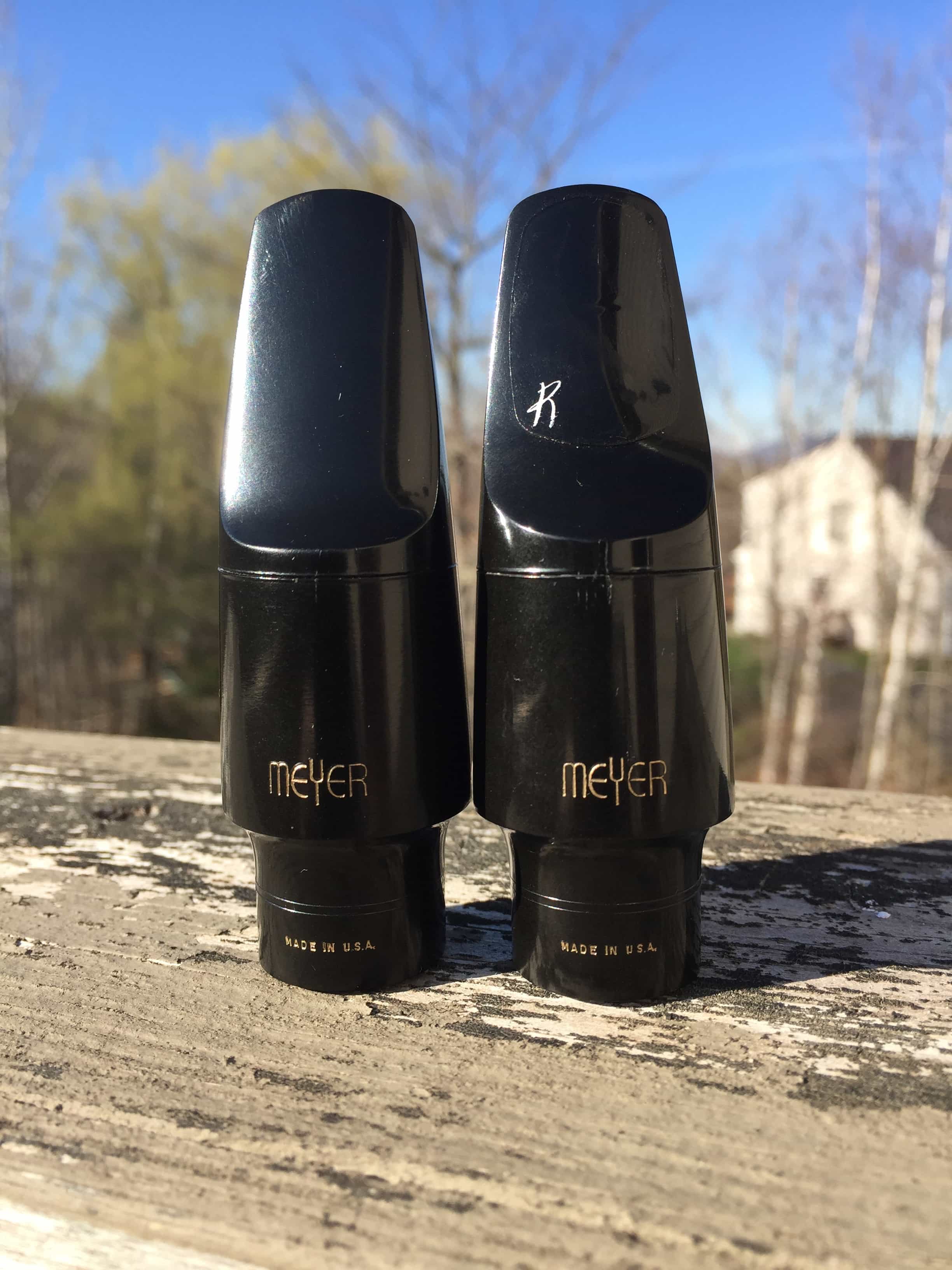
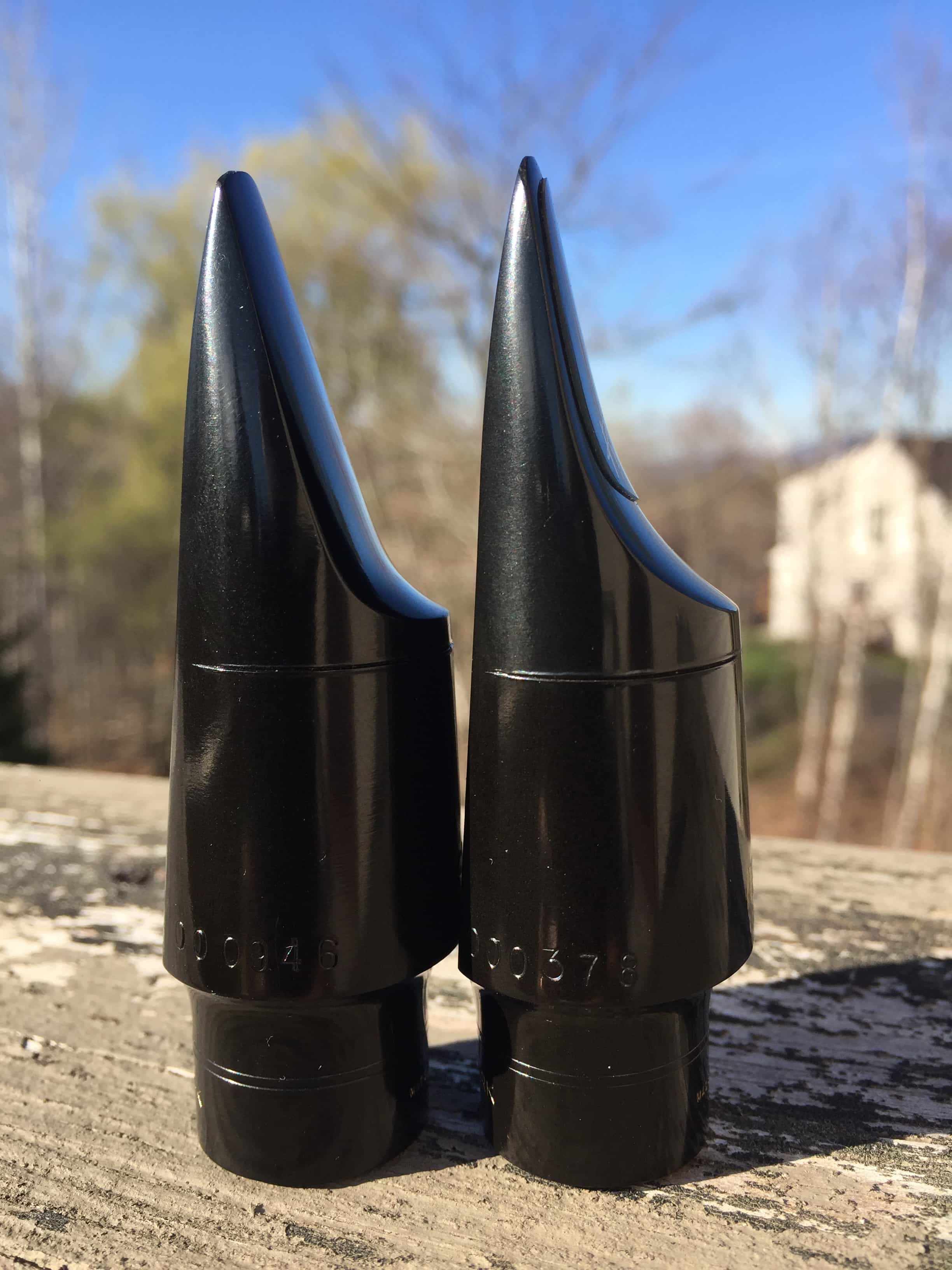


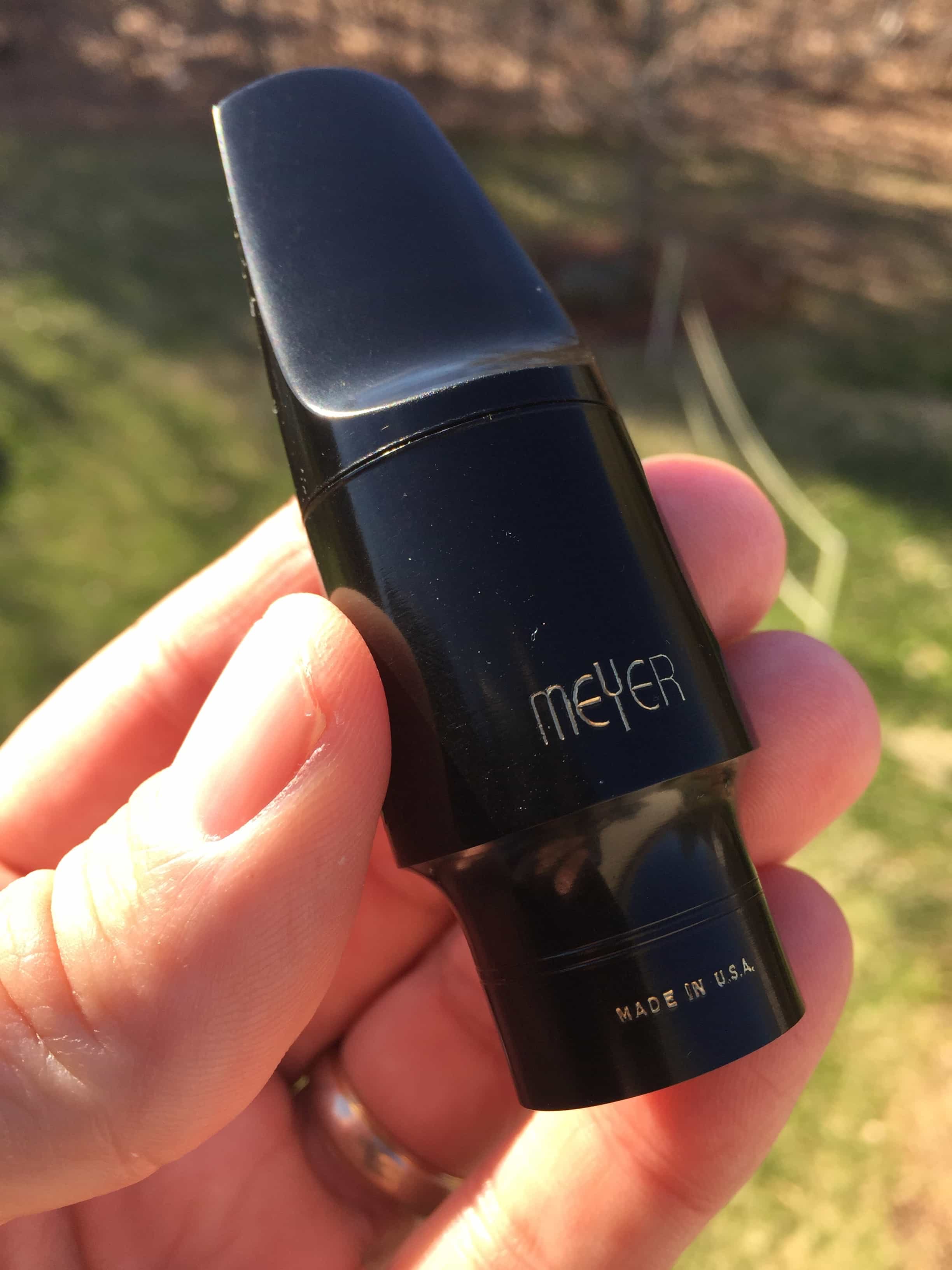
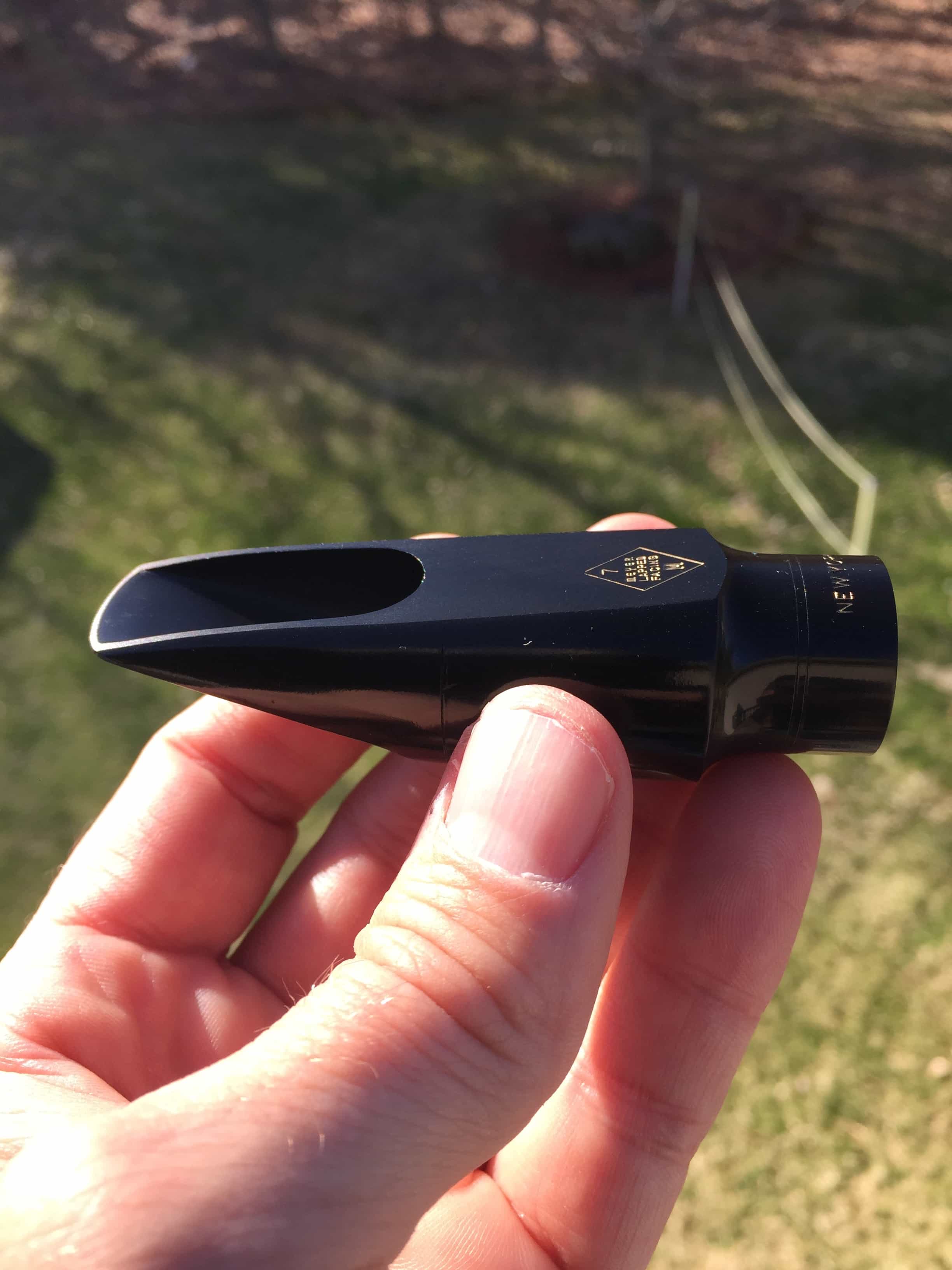


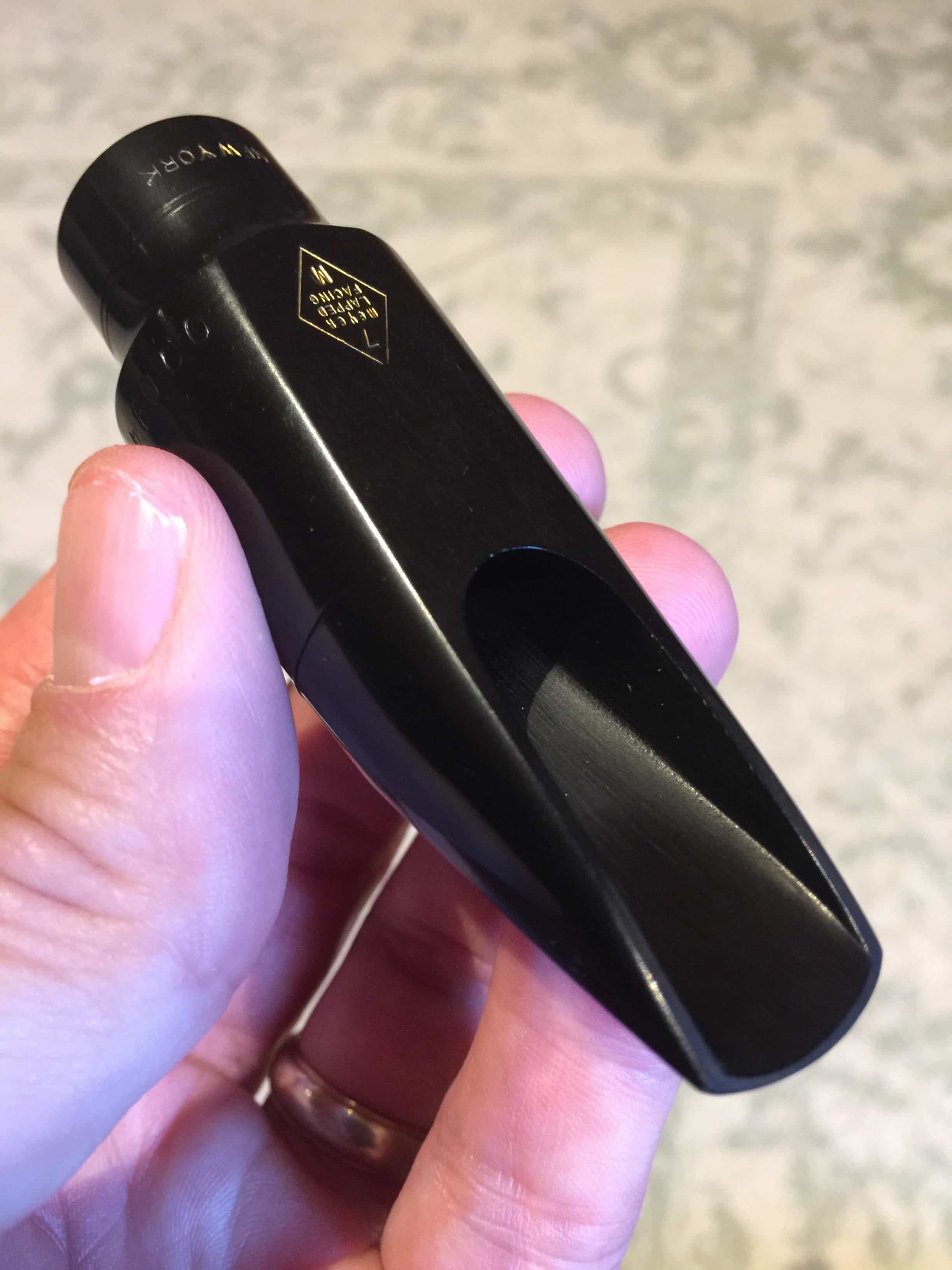

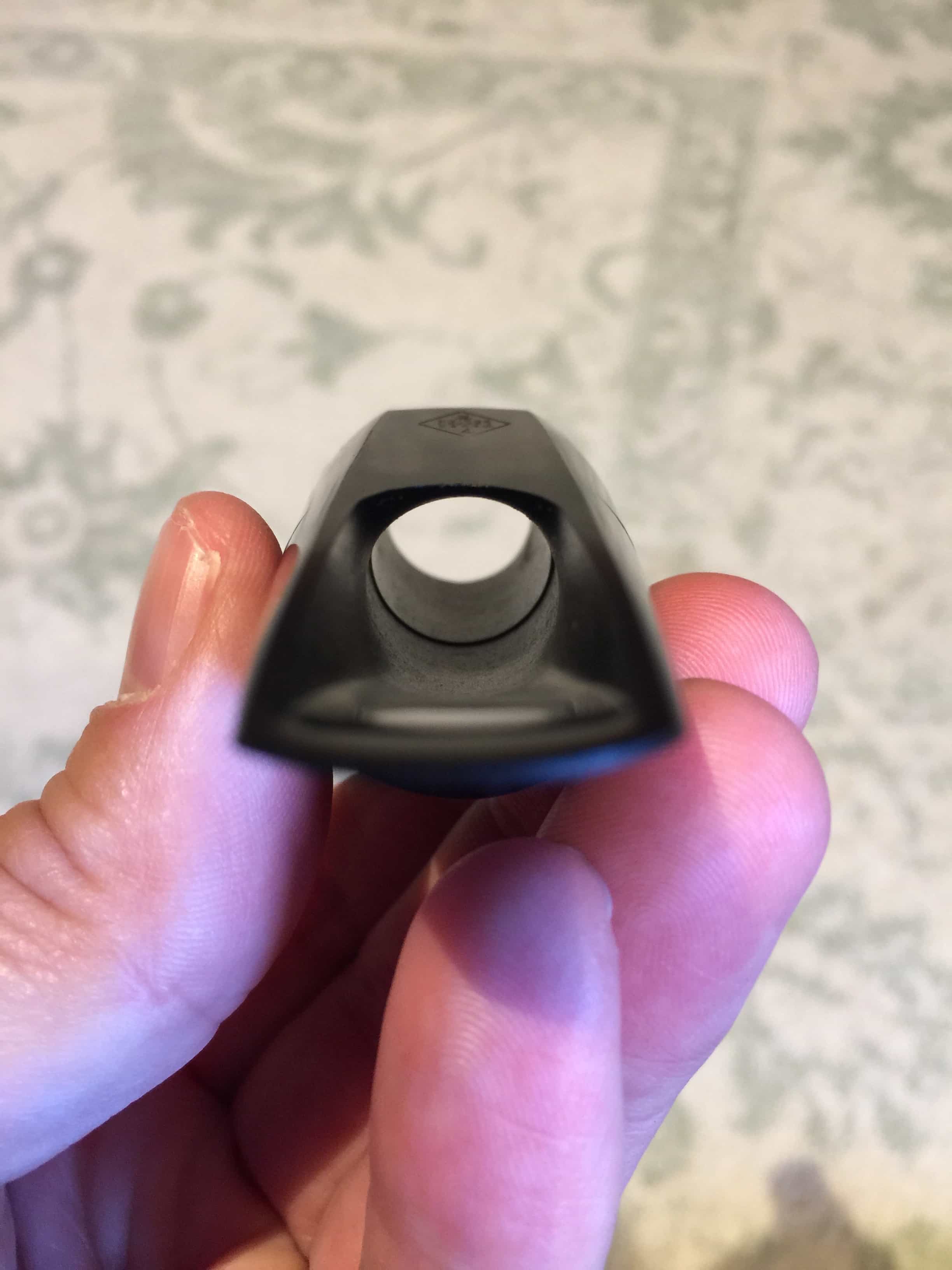



Babbitt is going to sell a boatload of these.
I do think the duckbills sound different. I think the #7 regular bill is my favorite. It’s a little less bright, and has a nice body to the sound.
Michael, I agree. I think that was my favorite while playing it. Steve
Steve,
Sounds very Phil Woods’ish
Beautiful playing . In you capable hands , the classic Meyer Alto Sax tone , lives on . MM
Thanks Murray!
Regular Beak 7 sounds like the Shizzle! I hope they take care with the finish work. I will definitely look into one of these. Thanks Steve.
The Regular 6 has more punch, and it seems to me the high notes responded better and faster than on the 7. The 7 had a little more spread, but still great. I understand Cannonball used a Meyer 5 and a pretty soft reed and I love his sound. Either of these pieces should work fine if you match up the reed… for me I’ll take the 6…. for now 😉
I bought one of the 7 Duckbills from Kessler and I’ve been playing lead alto with it in my big band. I like it a lot. I’m using Java Green 2.5’s and I love the tone I’m getting as well as the response and intonation.
Regular 7 has the warmth. Altos always cut through anyway. I have early 5, 6 and 7, and always come back to the 7. it has a bit of extra headroom so I can push it if needed. Great playing Steve as usual. Thanks so much for your dedication.
Very Nice Work Steve, especially on the Regular 7.
Warmer but with a little edge. You’ve got me thinking now!
Thanks for your enthusiasm & diligence with your insightful reviews.
Thanks Alan. I think the 7 was my favorite. I’m kinda wishing I kept it at this point……..
They all sounded great. All 4 have their own beauty. Loved them all.Anthony. Thanks Steve
Hi Steve, I rarely post comments as I am stranded on my island far away from any decent music stores and cannot make ideas after trying your suggestions.
This time, I am because I have 2 Meyers (7 for the alto and 8☆ for the tenor and they are my favorites. I would love to try the vintage ones.
My second remark is about the difference bet ween “aural” and “oral”. I may be wrong but I think that the first word is related to the ear and the second one to the mouth. I don’t believe though talented you are you can blow your horn using your ear cavity. (Lol).
Thank for your educative job. I am a fan.
Haha! So true! Thanks Patrick. I’m glad to have a multitude of proofreaders out there that can help me catch these types of mistakes. I appreciate it. Steve
Steve, thanks for another useful and enjoyable review. I would really appreciate your opinion and that of other players about the differences between this 100th aniversary mpc vs Theo Wanne`s NY Brothers mpc?
Paul, It’s probably best to listen to the sound clips and see what differences you hear. I seem to remember the TW NY Brothers mouthpiece as having a very pure beautiful sound. I remember really liking that about it. I don’t remember much else about it in regard to the differences between the two mouthpieces. There is a definite difference in sound in my opinion but I think the clips would be the most helpful rather than my words. Steve
Steve: I like the # 7’s the best. That being said the # 7 w/the Duckbill seems to have a more open sound which I like.
Thank you for doing this and I hope you’re feeling better.
Larry,
Yes, I am feeling much better. I had a new shunt put in my head last October and feel back to my normal self again. Thanks for asking. Steve
Vince Salerno is on the money, Babbitt will sell boatloads and I’m in Britain waiting for that boat to arrive.
Hey Steve. How about the Meyer G. I listened to you playing one from 2009 and it sounded good.
Andrew, Yes, the Meyer G I reviewed was very good also. I have only played two of those and both played really well. Steve
Hey Steve, first, I’d like to say you are a wizard on sax: super clean and super fast. However, the sound lacks to my ear. Is it the reed, or is it the mouthpiece? I play on a 53 Zephyr with new pads and gold resonators from Music Medic. I had the work done in MD at Chuck Levin’s. I play on a #3 Red JAVA with a regular Meyer 6M that I purchased at Christmas. My sound, to my ear, is much fuller and richer while still being darker then yours. Is it my setup or is it the mouthpiece? I don’t know. However, I would not spend $200 for the NY over $130 for the one I have. However, I must conclude by also saying that I’ll never have the speed and depth of knowledge as you, good kind sir. So thanks for the review however, I’m going to pass on the NY. Best wishes Harold.
Harold, It could be the reed or the mouthpiece or it could just be me and how I play. Who knows, I might try playing your exact setup with your reed and get a much brighter tone than you do because of the differences between our embouchures, tongue positions, size of oral cavity, speed of air, etc…… I had a guy come in my studio a few months ago and try a bunch of my mouthpieces and I thought he sounded way darker than I do on the same mouthpieces. Thanks for coming by the site and commenting. Steve
Hmmm, could be Steve. Also, more then most likely it’s the horn. I honestly regretted having the gold plated resonators installed because I was playing on an Otto Link. Dang the sound was really bright, not what I expected. Then I hooked up the Meyer’s with it and wow: I love it!! Maybe I’ll try the NY … WW&WB are having a 12% off sale right now. Still it’s a lot of money for a novelist like myself. Thanks for replying, Harold
H D Petty, It could be that you’re listening to Steve on a speaker system that doesn’t truly represent Steve’s sound.
Hey Paul Dion, same system I’m listening to my 53 Zephyr on and with all due respect I’m not comparing my playing … I’m just comparing the sound … Seriously though, probably is the gold plated resonators.
Ideally, in a perfect world, we would all love our saxophone’s tone more than all others. I know when I am playing and everything is working perfectly I am in heaven. I wouldn’t trade my tone for anyone elses in those moments…….
Well said …
Hey Steve, nice review. I just picked one up in a 5M And it’s great! I normally play around a 7 or 8 in alto mpcs, but I also like 5s or 6s for a brighter, more focused sound. Can’t compare to vintage but this is definitely the best production Meyer I’ve ever tried … immediately out the box I was happy with the sound. Haven’t found “the” reed for it yet but Vandoren Java Red 3 1/2 works pretty well for me. I think it pairs best with a very responsive reed.
My favorite current piece is a First generation Short Shank soloist I had Brian Powell reface to a “7” and this new Meyer is almost as good! That’s really all I can say about that.
-Lorenzo (BATMAN from Sotw!)
I’m getting three 5M’s and three 6M’s in next week. I’m looking forward to trying these out in the shop.
Hello, is it safe to assume that mouthpieces with serial numbers greater than that of the normal beak example viewed in the picture (000946), will also have a normal beak arrangement? Or should I aim for a serial # well above 1000? I would like my current Meyer pieces even more if the beak area was a little fuller so I certainly don’t want duck action.
Thanks,
Joseph
I believe they all have a normal beak now from what I have heard. I assume all of the pieces after 946 are regular beaks. Steve
Hey Steve, I finally purchased the 100th anniversary NY mpc: I find that it’s not quite as dark as my Meyer 6M although it’s everything you said it is. Super easy air action and easy to play extremely softly! I won’t be getting rid of my 6M old school mpc I’m glad I purchased it. I will say for me, in my 52 Zephyr with gold plated resonators, it’s going to take a little time getting use to the slightly brighter sound. Best regards, Harley P.
That’s great to hear Harley. I’m glad you like it. I find that many times when I find a mouthpiece bright, it seems to tend to darken over time to my preferences. I’m not sure how but I think my body and playing morph a little bit to get closer to the sound I hear in my head perhaps. Thanks for stopping in and telling us your impressions. Steve
Hey Steve, thanks for taking the time out of your busy schedule to reply. After playing the new NY for awhile, I’d have to agree with you and I find my old Meyer stuffy and not a lot darker. The ability to take a note and crescendo it then diminuendo it while bending the note is incredible and at the same time projects such clean sound is remarkable! Truly an awesome mpc! Thanks again for being there for me when I need advice: Harley
Many thanks Steve. I’m 75 now and after listening to your demos on the NY Meyer I just might treat myself to a long deserved treat. Thanks also to you guys that post comments. really helpful in arriving at a balance. Does that sound daft?
I finally purchased one after inquiring about the duckbill cutoff in June. I have no complaints about play. It is a little on the bright side relative to the standard Meyer line which I don’t mind at all and performs with low pressure resistance. I did notice that the window is off center a little at the table end of the mouthpiece although it doesn’t appear to have any affect on play ability.
The ligature did leave a mark on the mouthpiece and as nice as it looks with the matching Meyer name pressed into it, I’m not sure what to say about the fact that one of the very loose fitting ligature screws just fell out of it and can be pulled out of it as if something is stripped out. I’m not on the verge of crying about it and swapping the screws around seems to have made it better. The mouthpiece is definitely a keeper for me, it plays different from anything else I have and I like it.
Sounds great Steve! Im in a bit of a mouthpiece dilemma, and would like your input. Ive been playing on a Mouthpiece Cafe Espresso for about 2 years now, but dont feel like it will fulfill what I want out of the type of sound tendencies it has. I’ve looked at all the Ted Klums, other mouthpiece cafe pieces, Drake pieces, Vandoren, and have tried all of them. What I’m looking for i guess is a clean slate, something I will buy, and play on til I die lol, and not be limited. In your opinion, do you think the new New York Meyer would fulfill that? Money is not an issue, as I will likely not change after this decision. If you have suggestions on a better alternative to that type of vibe, please let me know. Thanks in advance.
Garret, This is an impossible question to answer for me. You haven’t given me any information except that you want a “clean slate”, something you will “play on until you die” and “not be limited”. There is no possible way I can help you because those three things you are requesting aren’t able to be defined and have no characteristics that are measurable. You haven’t told me why the Mouthpiece Cafe Espresso can’t fulfill what you want. You haven’t told me what type of sound tendencies it has that you don’t like. You haven’t told me what you didn’t like about all the Klums, Mouthpiece Cafe, Drake and Vandoren pieces you have tried. I don’t know the sound concept you are going for, etc…….You would have to be more specific for me to point you in the right direction. Steve
Hi Garrett,
If you want to get an idea of various types of mouthpieces for alto, bearing in mind that the sound is not produced only by them but depends on you, on the sound you “think” and which, by studying, trying to reproduce or create, you can also visit the websites by 10 M Fan mouthpieces and Phil Tone mouthpieces, in the mouthpieces section for alto sax: in addition to the description of the characteristics there are also audio links of various saxophonists to give an idea of the sound of the various models; sound which, however, varies depending on who plays the mouthpiece.
There remains the possible problem of choosing the most suitable tip opening for you.
A greeting,
Giuseppe.
To Garret Kuchmaner: SO who do you listen to, who do you like on alto? If you listen to Charlie Parker, Sonny Stitt, Cannonball, or Phil Woods type player then you should consider this New NY 100th Edition Meyer. If you are going for a Sanborn sound, then no.
You should probably try a few different tip openings w/different reed combinations before you settle on 1 mpc. This being said, you cannot expect the mpc to do everything for you. You have to put in the time on the mpc in the practice room. Also you never said what kind of alto sax you’re playing and the condition of the horn..Take the horn to a Good Tech and make sure the pads are sealing, that your cork on the neck is tight on the mpc.
Nothing worse than trying to play a horn that leaks.
Larry W
I tried opening 5, 6, 7
Now I have set myself a 7 this is a good sound. Comfortable sound. The ligature works well with it, but it has weak screws…
Opening 6 sounds too tense. I can’t recommend it.
Opening 5 needs a different ligature, but it’s not a bad mouthpiece. It can be used.
The best is opening 7.
How would you compare this mouthpiece with the Drake Phil Woods mouthpiece??
I would say the Drake Phil Woods mouthpiece had more of a bright focus to the sound. More “zing”. The Meyer was more middle of the road and neutral when compared to the Phil Woods mouthpiece. The NY Meyer 100th still has some nice brightness and pop but not as much as the Drake Phil Woods. That is how I remember them…….
And the New Meyer Bros connoisseur??
What’s your favorite for the Meyer traditional sound vintage???
which of the three mouthpieces would you choose?
Off the top of my head I would say the Meyer Bros NY Connoisseur but I have those right here in front of me and have been playing them for the last week. I haven’t played the other Meyer versions in many years so can’t compare them side by side. The Connoisseur mouthpieces play really great though……..